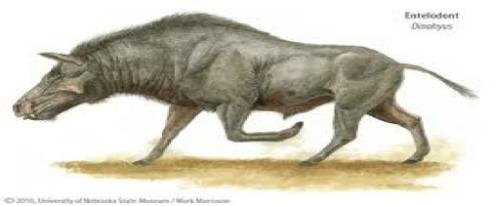Entelodont= Animal E
Entelodontidae, a group of large mammals related to living pigs. Entelodonts were contemporaries of oreodonts, a unique mammalian group thought to be related to camels but sheep like in appearance. Fossil evidence points to their emergence in the Middle (some 49 million to 37 million years ago) of Mongolia. They spread across Asia, Europe, and North America before becoming extinct sometime between 19 million and 16 million years ago during the early Miocene Epoch.
Entelodonts were medium-size to very large animals. The smallest ones grew to about 150 kg (about 330 pounds; the size of a large male white-tailed deer), whereas the largest ones, such as Dinohyus, weighed 900 kg (about 2,000 pounds; roughly the size of a Clydesdale horse). The skulls of entelodonts were also proportionally large, accounting for about 35 to 45 percent of the animal’s total length in Dinohyus. Entelodonts had distinctive tusk like projections of bone that grew out from the skull. These structures were related to the musculature and movements of the jaw during feeding, and they also might have protected sensitive areas of the head.
Compared with other ungulates, the structure of the jaw and musculature was remarkably like that ofcarnivores; the joint connecting the lower and upper parts of the jaw was in line with the dentition rather than raised above it. Some researchers interpreted the jaw structure as indicative of a carnivorous diet, but the overall structure of jaw musculature, the teeth, and the wear patterns on the teeth suggest a quite omnivorous diet. Entelodonts had specializations for eating tough or hard foods and were perhaps even capable of crushing bone. (For example, entelodonts possessed proportionally massive jaw muscles connected to large bony attachments on the skull and mandible.) Thus, like living pigs, entelodonts were probably mixed feeders, subsisting on a variety of plant and animal foodstuffs. Even though some entelodont species were extraordinarily large, their limb skeletons indicate that they were fully terrestrial and specialized for running.
Source: http://www.britannica.com/EBchecked/topic/188811/entelodont
The Survival of Animal E
This animal has a huge advantage in size. For example if challenged by a Hyaenodon, Animal E would break the shoulder bone of the Hyaenodon when the have a forceful run against each other. This giant also has great muscles in its skull and most of its body, hence giving it a muscular shape. Being more vicious than a grizzly bear adds on to its attitude to kill. It relied on its long thin legs and lightweight to boost itself to a speeding prey. Animal E would kill before eating. Proof is that it has gigantic carnivores teeth at the top of its mouth that could snap a tree log. But it also had herbivore teeth. These teeth are at the back of Animal E’s mouth. This proofs that Animal E was most likely to be an omnivore. But the real truth is that it will eat anything it finds to meet its taste criteria. Having simple brains allow itself to be mostly driven by instincts. Nerve in the brain also shows that it had a good sense of smell. This animal would ravel in a zigzag manner to find prey. It is an excellent scavenger. It would use its bulk to bring down almost all the other predators who has food that it wants. At first, it depended on other predators to catch food than chase off the predator and feed off its hard work. But the predators started to decline rapidly in time and soon had wipeouts of their species. Now with nothing more to scavenge, Animal A has to adapt.
Adaptation of Animal E
Over time, Animal E grew much bigger in size. From standing at 1.2m tall, it was now 2m and above. Now it could catch any animal there was. Running like horse and killing animals with a single blow by using their bulk was an ideal way to survive. But they became extinct, despite their horrible size, mass and attitude only to destroy.
Extinction of Animal E
Despite being top of the food chain, Animal E also had a weakness. Being used to chasing prey with great speed, did not really shed light on how to be in combat with very fast predators. This specific predator was the bear dog. It was extremely fast. It had sharper teeth. Other than the physical appearance, the bear dog has out beaten Animal E in almost every way. Soon Animal E was extinct because of a more distinctive predator.


